Abstract
FSP (friction stir processing) technology is a modern grain refinement method that is setting new trends in surface engineering. This technology is used not only to modify the microstructure of the surface layer of engineering materials, but increasingly more often also to produce surface composites. The application potential of FSP technology lies in its simplicity and speed of processing and in the wide range of materials that can be used as reinforcement in the composite. There are a number of solutions enabling the effective and controlled introduction of the reinforcing phase into the plasticized matrix and the production of the composite microstructure in it. The most important of them are the groove and hole methods, as well as direct friction stir processing. This review article discusses the main and less frequently used methods of producing surface composites using friction stir processing, indicates the main advantages, disadvantages and application limitations of the individual solutions, in addition to potential difficulties in effective processing. This information can be helpful in choosing a solution for a specific application.
1. Introduction
Friction stir processing is a new solid-state surface modifying technique used in surface engineering to modify the microstructure and properties of engineering materials, as well as to produce composite surface layers. FSP was invented by Mishra et al. [1,2], but it is derived from FSW (friction stir welding) technology, which was invented at The Welding Institute (TWI) [3] and is based on the same principles as FSW. In both the FSW and FSP methods, the heat generated by the friction of a special non-consumable tool against the surface of the modified material leads to plasticization of the material. Softening the substrate material is called plastic deformational softening [4]. The tool heats up the workpiece and causes movement of the plasticized material. The plasticized material flows to the back of the pin, where it is extruded and forged behind the tool, then consolidated and cooled under hydrostatic pressure conditions [5]. The associated effects of heat and pressure during FSP/FSW generate processes, the consequence of which are changes in the microstructure and morphology of the phases [6,7,8]. Both in the case of FSP and FSW technologies the obtained microstructural effects depend on the basic machining parameters, i.e., the rotational speed, travel speed, tool inclination angle, but also on the shape of the tool and its dimensions [9,10,11]. For example, Pouraliakbar et al. [12] analyzed the effect of the tool rotational speed, pin dwell-time and the processing environment on the grain size in the Al–Cu–Mg alloy. The samples were processed in air and under water. The authors found a favourable effect of the enhanced cooling on the degree of grain refinement in the FSPed alloy; the average grain size was within the range of 54.7–251.7 nm and 40.2–57.3 nm for the specimens FSPed in air and under water, respectively. The authors also showed that in the case of the water submerged processing technique, increasing the rotational speed of the tool or pin dwell-time did not cause such significant changes in the grain size as in the case of air cooling.
FSP leads, among others, to strong grain refinement in the modified material owing to dynamic recrystallization, which results in improvement in the functional properties of the material [13]. The only source of heat in FSP is friction, thanks to which the technology is classified as environmentally friendly. As friction stir processing is a solid-state process, there are no melting or solidification defects such as porosity or thermal cracks [14]. It is also worth adding that although friction stir welding and processing had been developed mainly for light non-ferrous metals [15], there are many reports of the successful friction stir processing of various grades of steel [16,17]. It is worth emphasizing that FSP technology can be used not only to modify the microstructure of the material, but also to produce surface composites. For the first time, FSP technology was employed to produce surface composites by Mishra et al. [18] On a sample made of 5083Al aluminum alloy, they applied a thin layer of SiC particles, which were previously mixed with methanol, and the layer formed in this way was dried in air. Subsequent FSP treatment allowed the SiC particles to be introduced into the plasticized matrix and a surface composite to be produced. Thanks to FSP, defects that form in the matrix alloy during, e.g., the casting process, can be effectively eliminated [19].
In FSP technology, the melting point of the matrix is not exceeded; therefore, only solid-state transformations take place during processing. Thanks to this, FSP technology allows the production of composites from components whose use in other technologies could be impossible or significantly difficult, e.g., due to the lack of wettability or unfavourable interactions between the components. Carbide powders SiC [20], B4C [21], WC [22], TiC [23], ZrC [24], oxide powders Al2O3 [25], SiO2 [26], ZrO2 [25], borides TiB2 [27] and nitrides [28,29], or their combinations, are the most frequently used as reinforcing material, but also, e.g., carbon nanotubes [30], stainless steel powder [31], diamond [25], hydroxyapatite [32] or fly ash [33]. The matrix of such composites is usually made of aluminum alloys [34,35], as well as magnesium alloys [20,30], titanium alloys [36,37] and copper alloys [38]. The effect of FSP processing is a consequence of the properties and contribution of the individual components making up the composite, additionally the FSP processing parameters [39,40], in particular the rotational speed of the tool, the tool tilt angle, the shape and dimensions of the pin and the dimensions of the shoulder. The degree and uniformity of reinforcement phase dispersion in the base material (BM) also depends on the number of process passes [41]. It is generally stated that increasing the number of passes has a positive effect on the uniformity of particle distribution [42]. This issue has been the subject of research of several authors, among others, Azizieh et al. [41] The authors analyzed a composite based on the AZ31 magnesium alloy reinforced with Al2O3 nanoparticles. Friction stir processing was carried out 2-to-4 times. The authors found that by increasing the number of the FSP passes, the size of the nanoparticle agglomerations distinctly reduced and the reinforcement distribution improved. They demonstrated that particle distribution can be significantly improved by increasing the number of FSP passes. A greater number of passes and the resulting greater uniformity in the reinforcing phase distribution, the smaller number of particle agglomerates, or greater particle refinement also have a positive effect on the corrosion resistance of the composite. Zaharia [43] showed that the reduction in SiC particle size significantly increased the corrosion resistance of the composite, and particle agglomerates are particularly susceptible to corrosion.
The properties of a composite produced with FSP technology are primarily the result of the properties of the individual components and their volume fractions; nevertheless, they are also a consequence of other processes taking place in the material during processing. High temperature and severe plastic deformation during friction stir processing lead to the dynamic recrystallization of the material (DRX), the consequence of which is strong grain refinement of the composite matrix. The presence of reinforcing phase particles and their size also influence the grain refinement. These particles, located at the boundaries of the newly formed grains, can prevent grain growth through the Zener pinning mechanism. For example, Moharami et al. [44] investigated friction stir-processed Al–Mg2Si composites and found that the micron-sized Mg2Si particles averted excessive mobility of the grain boundaries and effectively prevented grain growth through the Zener pinning mechanism. Additionally, Heidarzadeh et al. [45], who analyzed the effect of Al2O3 nanoparticles on the microstructure of FSPed pure copper, found that significant grain refinement of the matrix is caused not only by the continuous DRX mechanism (CDRX), but also by the fact that nanoparticles limit the growth of DRX grains by the Zener pinning effect. It is worth noting that the addition of nano-sized particles leads to greater grain refinement of the composite matrix as compared to micro-sized particles [19].
The natural consequence of strong grain refinement is, of course, improvement in the mechanical properties of the material, including its hardness [19]. The relationship between grain size and material hardness is described by the Hall–Petch relationship. The increase in the hardness and strength of a material is also due to the Orowan strengthening mechanism. In a composite, dislocation loops form around fine incoherent phase particles, which constitute an obstacle to dislocation movement, and thus make it difficult or impossible for subsequent dislocations to slip, resulting in the strengthening of the material. Velmurugan et al. [24] noted an increase in the hardness of the Cu–Ni alloy up to 60%, which they explained by the fine-grain refinement, the dispersion of the hard ceramic ZrC phase in the stirring zone, as well as by hindering dislocation movement during plastic deformation and an increase in dislocation density in the matrix. In turn, Pol et al. [46] indicate that the Orowan strengthening mechanism is one of the main reasons for the significant increase in hardness in the case of an FSP composite with an AA7005 aluminum alloy matrix reinforced with B4C and TiB2 particles. The mechanical properties of the composite also depend on the amount of reinforcement phase, and of course, the type of reinforcement material used. Most often, hard ceramic particles are introduced into the alloy matrix, the mere presence of which enables a significant increase in the hardness of the composite.
FSP technology is a relatively inexpensive, simple and quick solution that does not require the use of specialized equipment. Machining is most often performed by means of ordinary machining tools, thanks to which the implementation of FSP technology in industrial conditions is relatively simple and does not involve complex or costly adaptation works [47].
The key issue in the production of composites using FSP is the method of introducing the reinforcing phase into the matrix. Currently, there are a number of solutions and methods allowing effective introduction of the reinforcing phase to the surface layer of the modified material and formation of the composite microstructure in it. The best-known methods are the groove method, the hole method and direct-friction stir processing (DFSP). FSP technology can also be used to modify the microstructure of finished composites, e.g., in order to eliminate manufacturing defects, homogenize the material and improve the properties of the composite.
The main purpose of this work was to review the methods and solutions used to produce a surface composite employing FSP technology. The article is not limited to a specific matrix material or a specific type of reinforcement phase, but rather focuses on the technological aspects of producing composites. The study presents individual solutions and shows their main advantages and disadvantages, application limitations in addition to potential difficulties in effective machining. According to the authors of the publication, the study may be helpful in choosing a solution for the production of surface composites.
2. Methods
2.1. Groove Method
In analyzing the literature data, it is noticed that the groove method is the most frequently chosen solution to introduce the reinforcing phase into the matrix. The dominance of the groove method is partly due to the fact that it was the first method used in the production of a surface composite with FSP technology, and initially, there were no competitive solutions which enabled its dynamic expansion and dissemination.
In the groove method, three stages can be distinguished: (1) cutting a groove in the sample and filling it with the reinforcing material, (2) closing the groove containing the reinforcing material using a pinless tool, and (3) the distribution of the particles in the matrix using a tool with a pin [48]. A diagram of the groove method is shown in Figure 1.

Figure 1.
Diagram of groove method (a) (authors’ own drawing); sample for processing with groove method (b).
As mentioned above, two types of tools are needed in the groove method. As observed in the literature, researchers use various tool designs. Nevertheless, a pinless tool with a flat shoulder and a tool with a cylindrical pin comprise the most frequently utilized toolset [49,50,51] in the production of surface composites. Some researchers have investigated the effect of the tool geometry on the performance of the process. Gangil et al. [52] compared the operation of four tool profiles with different shoulder and pin geometry in the distribution of reinforcing particles. A simple cylindrical pin with a simple shoulder and a shoulder with an anticlockwise scroll, as well as a right-hand and a left-hand threaded pin with a simple shoulder, were investigated. They found a significant influence of the tool geometry on the surface quality and microstructure of the produced composites. The authors revealed that the use of a scrolled shoulder resulted in a very rough surface. More efficient dispersion of the reinforcing powder was obtained by employing a left-hand threaded pin with a simple shoulder.
The groove method was also used by Sharma et al. [40] for the production of the Al6061-SiC-graphite hybrid surface composite. The authors analyzed the influence of the reinforcement and processing parameters on the mechanical properties, electrochemical properties as well as the size and morphology of the reinforcement and found that the rotational speed of the tool has a significant impact on agglomerate dispersion, the uniformity of the reinforcing particle distribution and the grain refinement of the matrix material. Moreover, it was found that the hybrid surface composite exhibits better corrosion resistance than a monocomposite reinforced only with SiC particles or graphite. The better corrosion resistance of the FSPed WE43/nHA composite than the FSPed WE43, and especially the as-cast WE43 alloy, was also found by Cao et al. [51], who explain it by the strong grain refinement as well as the dispersion of hydroxyapatite particles in the composite matrix.
The influence of the rotational speed on the microstructure and hardness of the material was also investigated by Azizieh et al. [41] and it was found that increasing the rotational speed of the tool leads to improvement in the distribution of the reinforcing phase particles. The use of multi-pass FSP leads to more uniform distribution of the reinforcing phase particles, a reduction in the size of the particle aggregates, and consequently, to greater grain refinement in addition to an improvement in the mechanical properties of the material [11]. Rao et al. [27] analyzed the microstructure and properties of an Al/TiB2 composite fabricated by multi-pass friction stir processing. They found that an increase in the number of passes led to a rise in the tensile strength and hardness of the composite. The hardness values were 15.85%, 26.80%, 56.0% and 61.0% higher than the hardness of BM (base material) after 1 pass, 2 passes, 3 passes and 4 passes, respectively. The authors concluded that the higher hardness is due to the more uniform dispersion of the TiB2 reinforcement and the reduction in grain size. They also found that the fewer the number of passes, the more agglomerates and small pores present in the microstructure of the composite.
In turn, Satish et al. [49] investigated the effect of different rotational speeds of the tool in enhancing the properties of the weld of the 8006 aluminum alloy by friction stir processing using zirconia particles as the reinforcing phase. The highest tensile strength of 284 MPa and the highest microhardness of 148 HV were obtained at the highest rotational speed of the tool, i.e., 1100 rpm. The corrosion rate was lowest when the highest rotational speed of the tool was applied.
Heidarzadeh et al. [53] employed the groove method to process a Cu-30Zn matrix both without reinforcing powder and with the addition of Al2O3 nanopowder having an average grain size of 30 nm. The tool rotational speed was 1120 rpm and the traverse speed was 50 mm/min. In turn, Gupta [54] applied the groove friction stir processing method to reinforce an Al-1120 alloy matrix using pine needle ash as a cost-effective reinforcing material that contains hard compounds of Si, Ca, K, Mg, and Fe. They used a tool rotational speed of 1400 rpm for all the samples, while the tool traverse speed and tool pin geometry were different. They found an increase of 15.81 and 18.13% in hardness and wear, respectively, for a sample that was processed utilising a threaded pin tool and the traverse speed of 56 mm/min. In turn, Liu et al. [55] carried out the groove-friction stir processing of AZ31 magnesium alloy with the addition of Al, Al–Si, and Al–SiC composite particles as the reinforcing powder. The maximum and minimum self-corrosion potential were observed in the samples reinforced with Al–SiC particles and Al–Si particles, respectively. They also found that the weight loss of the sample reinforced with Al–Si particles was lower compared to the AZ31 alloy. This was due to the different wear mechanisms that were observed for these materials, namely, severe abrasion and adhesion, in addition to mild abrasion for the Al–Si reinforced composite and AZ31 alloy, respectively.
The uniform distribution of the reinforcing powder and the prevention of powder agglomeration are important quality factors that determine the properties of the produced composite. Increasing the number of process passes is the most appropriate solution to prevent agglomeration. Cao et al. [51] produced a nano-hydroxyapatite (nHA) reinforced WE43 alloy by means of friction stir processing. They reported a good distribution of the nHA particles when two passes were performed, which also resulted in finer grains compared to friction stir processing without any powder. They also reported deterioration in the strength of the composite in comparison to the FSP base metal due to agglomeration of the reinforcement particles as well as poor bonding at the matrix-reinforcing particle interface.
The reinforcement material is usually added in the form of a powder. In most cases, only one powder is added to the groove; however, hybrid surface composites can also be produced via friction stir processing [40]. In some studies, thin sheet metal is the form of reinforcing material that is used.
For example, Liu et al. [56] presented a solution based on the groove method, but using the reinforcing material, not in the form of a powder but in the form of a solid strip placed in a groove in the surface of a sample made of 5A06 aluminum alloy. The authors used an amorphous Al–Ni–La strip with a thickness of 65 µm. FSP led to the production of a 6 mm deep-surface composite with a characteristic “sandwich structure”. The authors demonstrated that the obtained composite is characterized by higher corrosion resistance in a saline solution than the material without the amorphous strip.
In turn, Papantoniou et al. [50] employed a thin sheet of pure copper with a thickness of 0.8 mm to reinforce a solid AA5083 matrix, and Fernandez et al. [57] used graphene nanosheets to reinforce an AA1050 aluminum alloy matrix.
Literature data demonstrates that groove friction stir processing is an effective process for the production of surface composites where achieving increased hardness is usually the main purpose. Gangil et al. [52] fabricated magnesium-based composites reinforced with nitinol particles (NiTip) by means of the groove method and found a significant increase in microhardness due to the addition of reinforcing particles. Srivastava et al. [58] investigated the effect of the number of passes (one, two, and three passes) on the production of surface composites using A359 as the matrix and Si3N4 as the reinforcing powder. According to the results, the maximum tensile strength and hardness were 576 MPa and 125 HRB, respectively, which were achieved with one pass, while the maximum wear loss and thermal expansion were observed when three passes were performed. Butola et al. [59] produced an Al7075/SiC surface composite by implementing groove friction stir processing. They utilized a tool with a square cross-section pin and investigated the effects of two tool rotational speeds, namely, 700 and 1000 rpm, on the strength, hardness, and wear resistance. They found a decrease in ductility and tensile strength as a result of adding a reinforcing powder, but in turn, increases in microhardness and wear resistance were observed.
In the case of the groove method, the tool travels most often along a groove filled with reinforcement material. Ding et al. [37] used a different strategy of producing a composite layer. The authors used the groove method to introduce TiO2 particles, but the grooves in this case were located transversely to the direction of the tool travel (Figure 2). The applied solution proved to be effective. The authors obtained uniform distribution of the TiO2 particles in the matrix of the titanium alloy and strong grain refinement in the stirring zone.
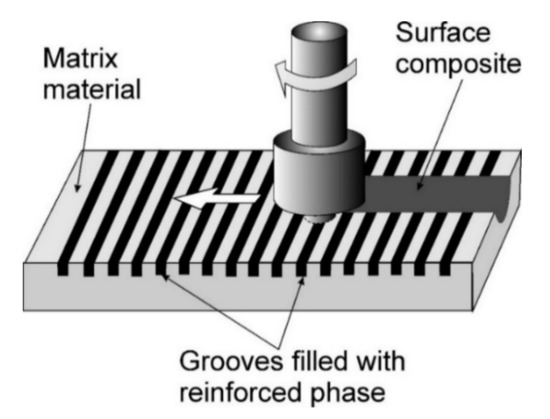
Figure 2.
Diagram of groove method with grooves located transversely to direction of tool travel (authors’ own drawing).
The list of cited works by the type of composite, FSP parameters and main results is presented in Table 1.

Table 1.
List of cited works.
2.2. Hole Method
An alternative solution to the groove method is the hole/chamber method (Figure 3). In this method, instead of a groove cut in the surface of the material, a system of separated chambers/holes located along the direction of tool travel is employed [60]. The use of isolated chambers/holes causes the powder to be dosed cyclically into the plasticized matrix, i.e., chamber after chamber, and moreover, the walls separating the individual chambers from each other protect the powder more effectively than in the groove method against uncontrolled movement of the reinforcing phase outside the modified area. Thus, machining can be performed without the step of closing the holes with a pinless tool. In this case, the machining is a one-step process and only one tool is needed, i.e., a tool with a pin. This is a great convenience and one of the main advantages of the hole method. The hole method also allows easy control of the target share of the reinforcing phase in the matrix of the modified material by selecting the dimensions and arrangement of the holes, as well as the thickness of the walls separating the individual holes from each other. Sharma et al. [61] also showed that the hole method allows greater homogeneity of the particle distribution compared to the groove method. The disadvantage of the hole method, however, is that the sample preparation time is longer than in the groove method, i.e., the time-consuming and laborious process of making the holes and their subsequent filling with the reinforcing phase. Furthermore, it is worth noting that the critical place in the chamber method is the wall that separates the individual holes from each other. This wall should not be too thick as it may result in the production of a local zone with a reduced proportion of the reinforcing phase in the place of its occurrence. Nonetheless, the non-uniformity of the distribution of the reinforcement phase particles can be eliminated by an additional pass or several passes.
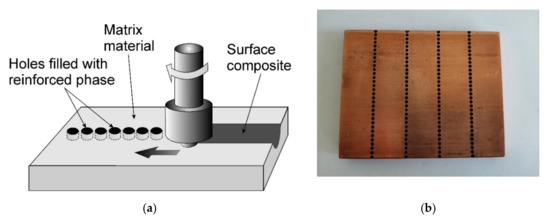
Figure 3.
Diagram of hole method (a) (authors’ own drawing), sample for processing with hole method (b).
In work [38], the hole method was used to produce a composite in the surface layer of pure copper (Figure 4). The reinforcing phase was SiC powder, which filled the holes up to ¾ of their height. As a result of the FSP treatment, a composite layer approximately 5.5 mm thick was obtained with an average share of the reinforcing phase equal to 9.4% ± 1%. The effect of dynamic recrystallization of the material accompanying the FSP treatment was strong refinement of the matrix grain, as the grain size was over 21 times smaller than the grain size of the base material. The consequence of the microstructural changes in the copper, especially the formation of the composite microstructure, was an increase in the hardness and wear resistance of the material.
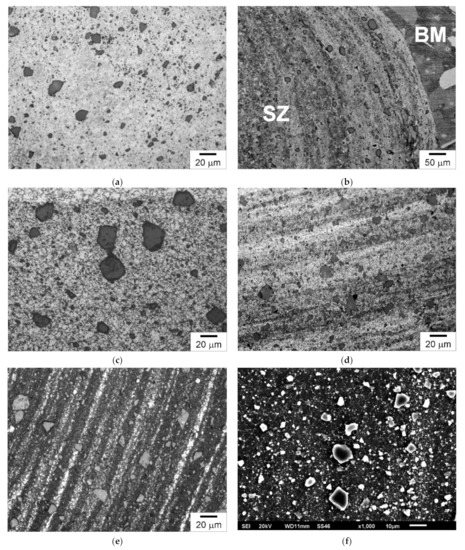
Figure 4.
Microstructure of Cu/SiC composite (a,b), AZ91/Cr2O3 composite (c), AA7075/SiC composite (d), AZ91/SiC composite (e,f), light microscopy (a–e), SEM (f), etched (authors’ own materials, unpublished).
In turn, Pol et al. [46] used the hole method to produce a composite in the surface layer of the AA7005 aluminum alloy. The reinforcing material was a composition consisting of B4C and TiB2 powders. Holes 1.5 mm in diameter and 3 mm deep were drilled in the surface of the sample made of AA7005, and then filled with a reinforcing phase. Two passes in opposite directions were made to obtain a satisfactory dispersion of the reinforcing particles in the surface layer composite. It was found that the particles of the reinforcing phase were uniformly dispersed in the aluminum matrix, and the hardness of the material increased from 90HV for the base material to 150HV for the composite. Singh et al. [62] used SiC particles as reinforcement to fabricate an aluminum metal matrix composite via friction stir processing. The SiC particles were additionally wrapped with a layer of graphene oxide. The SiC particles were introduced into drilled holes 2 mm in diameter, 4 mm deep with a 3 mm distance between the centers of two consecutive holes. Thanks to coating the SiC particles with a layer of graphene oxide, the authors created a composite characterized by higher strength, a smaller grain size and a lower tendency of the SiC particles to agglomerate than in the case of the unmodified samples. Khan et al. [21] assessed the effect of hole spacing on the microstructural and mechanical properties of the composite. In a sample made of aluminum alloy Al5083, holes were made with a diameter of 2 mm and a depth of 3 mm in which the reinforcement was placed. Two different spacing distances between the holes were selected, i.e., 8 mm and 10 mm. Three types of composites were made, namely composites reinforced with B4C particles, with multiwall carbon nanotubes (MWCNTs) and with a mixture of B4C and carbon nanotubes. As a result of the study, the authors found that the spacing between the holes plays an important role in generating defects and the collapse of the reinforcement particles. Namely, it was found that the distance between the holes of 10 mm allows the production of a composite with better mechanical properties than in the case of 8 mm hole spacing. Liang et al. [30] fabricated AZ91D/CNT nanocomposites by single-pass FSP and ultrasonic assisted extrusion. They achieved satisfactory dispersion of the carbon nanotubes in a magnesium alloy and good adhesion at the interface between the CNTs and the Mg matrix. The produced composite with a 1% CNT content was characterized by a tensile strength higher by ~ 25% than the AZ91D alloy, a yield strength higher by 13%, and the modulus of elasticity higher by ~12%. The authors explained that the improvement in the properties was due to the good adhesion at the interface between the CNTs and the Mg matrix. Kraiklang et al. [4] analyzed the effect of the number of passes on the properties of the composite produced by means of the hole method. Holes 2 mm in diameter and 4.5 mm deep were drilled in a sample of AA5052 aluminum alloy and then filled with SiC powder. Two tools were used to perform surface treatment; first, a pinless tool to close the holes, and then FSP was performed with the pin tool. The authors found that, as the number of passes increases, the tensile strength of the composite rises, but unfortunately the wear rate of the tool also grows. Unlike Kraiklang et al. [4], Wang et al. [36] used only one tool to form titanium matrix composites. The matrix of the composite was made of Ti–6Al–4V titanium alloy, and the reinforcing phase was B4C particles. The tool used in the FSP was equipped with a pin.
Analyzing the literature data, it can be noticed that in the case of the groove method, the final treatment with a tool equipped with a pin is preceded by treatment with a pinless tool, while in the case of the hole method the use of two tools is rather sporadic, and the treatment is performed with a tool equipped with a pin.
2.2.1. Zigzag Hole Pattern
The chambers in the hole method can be placed one behind the other along the direction of tool movement [21], but as it was shown in [63], a more uniform distribution of the reinforcing phase in the composite is obtained when using the zigzag hole pattern (Figure 5). The zigzag hole pattern was used, among others, by Sharma et al. [61] for the production of hybrid (B4C + MoS2) surface composites in the surface layer of the AA6061–T651 aluminum alloy. For this purpose, 80 blind holes in 2 rows with the zigzag pattern were drilled in the sample. The diameter of the holes was 1.5 mm and the depth was 2 mm. The distance between the holes was 1 mm. In addition, a composite with the same composition and content of the reinforcing phase was made, but by the groove method. In the case of the chamber method, better wear resistance was obtained compared to the groove method, which the authors explain by the higher homogeneity of the particle distribution in the composite. Akramifard et al. [64] produced Cu–SiC surface composites using FSP and showed that the surface hardness was twice as high as that of the substrate. The presence of hard and wear-resistant SiC particles in the metal matrix also increased the wear resistance of the copper. In turn, Sabbaghian et al. [65] used a zigzag hole pattern to produce a Cu–TiC composite and found homogeneous particle distribution in the matrix in addition to good bonding of the reinforcing particles to the base metal. The consequence of the formation of the composite microstructure was a very significant increase in the hardness of the material. The zigzag variant was also used by Mohamed et al. [66] to produce SiC/A380 composite.
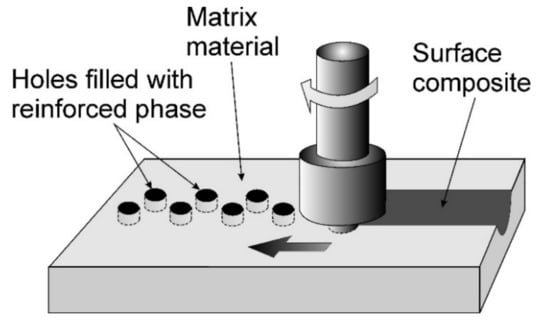
Figure 5.
Diagram of zigzag hole method (authors’ own drawing).
2.2.2. The Hole Method with the Offset Line of Holes
One of the variants of the hole method is a solution with an offset line of holes in relation to the moving tool. Iwaszko et al. [67] demonstrated that during FSP, it is advantageous when the axis of the moving tool is shifted in relation to the axis of the holes by a certain value ΔL (Figure 6). In this case, the pin of the tool does not sink centrally into the chambers filled with the reinforcing particles, but only partially engages the pin with the powder filled hole. As a result, the contact of the pin with the reinforcing phase takes place to a large extent with the participation of the matrix, already plasticized in the meantime, which partially neutralizes the abrasive effect of the reinforcing phase on the pin and reduces the intensity of pin wear. In the above variant, however, it is necessary to apply a two-stage treatment because after a single pass of the tool, only preliminary and insufficient mixing of the reinforcing phase with the matrix is achieved. Proper mixing of the reinforcing phase with the matrix takes place only during the second pass, during which the tool pin moves centrally along the hole line. This solution gives the best distribution effect of the reinforcing phase, while reducing pin wear. Less wear on the pin, in turn, results in reduced contamination of the modified surface layer by material coming from pin wear. The use of the variant with an offset line of holes also reduces the risk of uncontrolled movement of the modifying material beyond the modified area, which is most intense when the rotating pin enters the reinforcement material. In [62], the 7075 aluminum alloy in the T6 state was subjected to FSP. Holes with a diameter of 2 mm and a depth of 4.5 mm were drilled in the surface of the sample. In the first phase, the tool axis was at a distance of ΔL = 2.5 mm in relation to the axis of the holes; in the second phase, the tool pin moved centrally along the hole line. As a result of the applied treatment, uniform dispersion of the reinforcing phase, i.e., SiC particles in the metal matrix of the alloy, was obtained; the difference between the place with the highest concentration of SiC particles in the mixing zone and the place with the lowest concentration did not exceed ~ 10%.
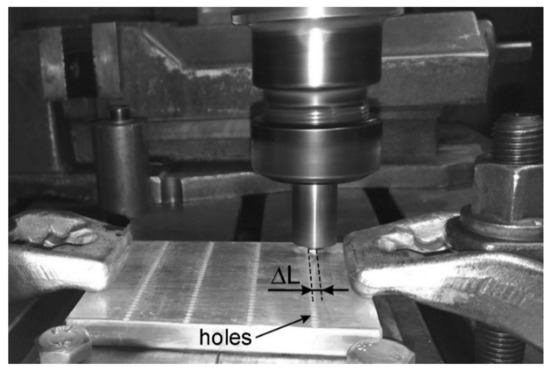
Figure 6.
FSP stand (authors’ own drawing).
2.2.3. A Deep Hole Drilled under the Surface
An alternative solution, though based on the idea of the hole method, is the method using a chamber/hole hollowed just below the surface, along the direction of tool movement (Figure 7). The location of the hole below the surface protects the reinforcement phase against uncontrolled movement outside the modification zone. As a result, machining can be performed in one step with only one tool. The main drawback of the method is, however, that it is limited in terms of the shape and maximum length of the hole. The holes are most often made with a suitably long drill or by the electro-discharge machining (EDM) method [68]. The limitations in the methodology of making the hole also limit the possibility of making holes with a course other than rectilinear. There is also a risk of surface perforation when making the hole, especially when the hole is mechanically hollow and at a small depth. Increasing the depth of the hole location reduces the risk of surface perforation, but in turn forces the use of a tool with a sufficiently long pin so that the reinforcing phase can be within the range of the working tool and can be introduced into the matrix. Prior to processing, the orifices of the holes are closed to prevent spillage of the powder during FSP. The disadvantage of the discussed method is the time-consuming filling of the hole and the possibility of gravity segregation of the reinforcing material in the case of using a multi-component composition in which individual components differ in specific weight or particle size. The deep hole method was used, among others, by Barmouz et al. [68] to form a pure copper composite layer. The reinforcing phase was SiC particles milled with zinc. The chamber was hollowed out 1 mm from the surface and its diameter was 1.5 mm. The authors used multi-pass FSP to improve the dispersion of the SiC particles and intermetallic phases in the matrix. The hardness of the composite layer was found to be higher with a greater number of passes. In turn, the grain size decreased with the number of passes and amounted to 2 μm, 1.5 μm and 1 μm, respectively, for the composite fabricated by 1-, 2- and 3-pass FSP. The grain size in BM was about 60 μm. The authors also found that a greater number of passes leads to more uniform dispersion of the reinforcement and intermetallic phases.
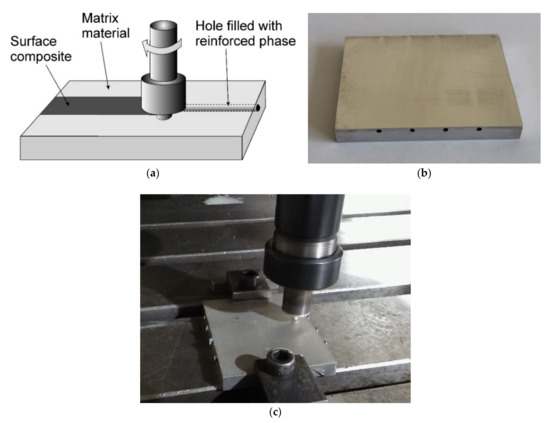
Figure 7.
Diagram of holes drilled under surface method (a) (authors’ own drawing), sample for processing with hole drilled under surface method (b), FSP stand (c).
The list of cited works by the type of composite, FSP parameters and main results is presented in Table 2.

Table 2.
List of cited works.
2.3. Sandwich Method
A diagram of the sandwich method is shown in Figure 8. The sandwich method is based on different principles than the hole or groove method. In the sandwich method, no holes or grooves are made, but the reinforcing phase is placed directly on the surface of the modified sample and covered with a thin layer/sheet of the sample material. The resulting sandwich assembly is processed by FSP with a pin tool. The number of layers can of course be increased, which also allows the amount of the dispersing phase in the matrix to be increased [69]. According to Houshyar et al., [70] the sandwich method is a simple and advanced process dedicated to large-scale metal matrix composites. The sandwich method was used, among others, by Mertens et al. [71] for the production of a composite with a magnesium alloy matrix reinforced with short carbon fiber. For this purpose, a layer of C fabric was stacked between two sheets of Mg alloy. After FSP treatment, the authors found that the C fabric was fragmented into short C fibers and introduced into the plasticized alloy matrix. The authors used different rotational speeds (500–1500 rpm) to simultaneously assess the effect of the FSP processing parameters on the microstructure of the composite and found that the composites made with a higher rotational speed were characterized by a more even distribution of fibers in the matrix. In turn, Houshyar et al. [70] used the sandwich method to produce a metal matrix composite reinforced with SiC particles. The matrix of the composite was in this case the AA3105 aluminum alloy. To make the composite, SiC particles were deposited as 1-mm-thick layers between 2-mm-thick sheets of the AA3105 aluminum using the spraying method. Two layers of sprayed SiC were located between two sheets of the AA3105 alloy. Multi-pass FSP (MP-FSP) was carried out. The authors found that the toughness and tensile strength of the composites grew with the increase in the number of passes (7.7 kJ, 7.8 kJ, 9.5 kJ, 10.6 kJ, respectively, after 1, 2, 3 and 4 passes), though in the case of the tensile strength only after the fourth pass was the strength higher by about 5% than in the case of the as-received AA3105.
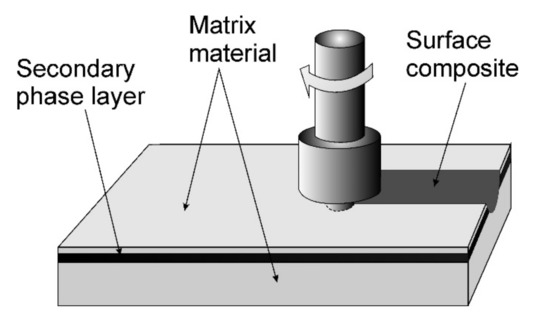
Figure 8.
Diagram of sandwich method (authors’ own drawing).
The list of cited works by the type of composite, FSP parameters and main results is presented in Table 3.

Table 3.
List of cited works.
2.4. Direct Friction Stir Processing
The essence of the DFSP method lies in the method of supplying the reinforcing material to the work zone and in the design of the tool. Unlike classic FSP tools, DFSP tools have an internal channel that introduces the reinforcement phase directly into the FSP work area by gravity or with additional force. The hollow channel in the tool also serves as a reservoir for the reinforcement phase. This avoids the time-consuming and labor-intensive production of a groove or holes and the equally labor-intensive subsequent filling with the reinforcement phase. The operator can also flexibly change the modified site depending on the current situation, technical conditions, hardware limitations, etc. In competitive methods, the direction of the tool movement and the places to be modified are precisely defined and it is not possible to make changes during the processing itself or such a possibility is limited. In this respect, the DFSP method seems to be the most promising solution for industrial applications. The disadvantage of the DFSP method is the limited capacity of the powder tank and the need for its systematic filling, which forces technological breaks in processing. There is also a risk of the powder feed channel plugging or uneven powder dosing to the modified zone. The potential problem with the plugging of the powder feed channel depends primarily on the diameter of the channel and the physicochemical properties of the powder, in particular the shape, size and degree of topographic complexity of the particle surface. The above-mentioned physicochemical properties of the powder determine the key technological parameter, which is the powder flow. In the DFSP method, there is no control either of the amount of powder actually introduced into the matrix at any given point in time, or the degree of emptying of the powder tank. After filling the powder tank with the reinforcing phase, but before proceeding with FSP, it is also necessary to protect the mouth of the channel against powder spillage. For example, Huang et al. [72] used a thin aluminum foil which rubbed off at the beginning of processing, allowing gravitational escape of the reinforcing phase from the tool channel into the space between the shoulder and the workpiece. Takhakh and Abdulla [73] also used aluminum foil to close the feed holes, and additionally used a 2 mm thick polystyrene disc. At the start of processing, the foil was rubbed off and the polystyrene was melted and evaporated.
The DFSP method was first used by Huang et al. [72] to form a composite microstructure in the surface layer of the AZ31 magnesium alloy. As the reinforcing phase, the authors used SiC particles with an average diameter of 1 µm. The authors used a special pinless tool with a concave shoulder and a through-channel drilled centrally in the tool, through which the reinforcing material was fed by gravity into the modified zone (Figure 9). The through-hole of the DFSP tool was also the container for the reinforcing material. This channel was filled with the reinforcing phase before processing, after which the reinforcement particles were introduced into the working zone using the force of gravity. Huang et al. [72] showed that when using DFSP technology it is possible to obtain a uniform and homogeneous dispersion of the reinforcing phase particles in the composite layer.
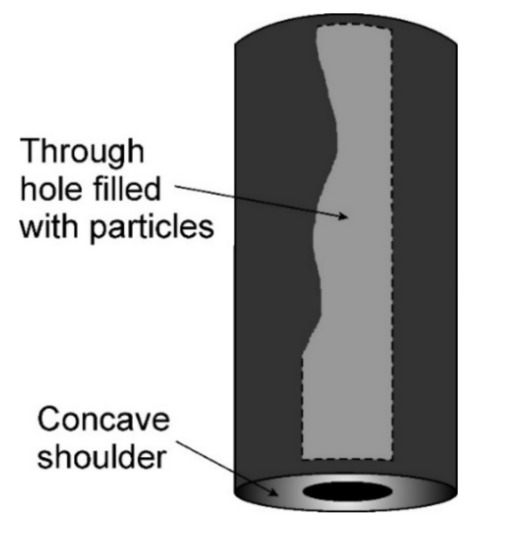
Figure 9.
Direct friction stir-processing tool (authors’ own drawing).
The DFSP method was also used by Almazrouee et al. [48] The main goal in this case was to produce a composite microstructure in the surface layer of the 1100 aluminum alloy. In order to introduce the reinforcing phase, i.e., SiC particles, into the metal matrix, the authors developed a two-part tool consisting of an inner threaded hollow cylindrical body and a pinless head containing a shoulder with a hole in the center (Figure 10). Both parts of the tool were screwed together. The use of a two-part tool made it possible to easily replace the powder dosing head with another one adapted to the currently performed processing. Microstructural tests of the composite layer obtained in this way showed the uniform distribution of the SiC particles and their very good adhesion to the aluminum substrate with a simultaneous increase in the hardness of the material. The authors did not observe significant wear of the tool as a result of its contact with the hard SiC particles, which was explained by the soft nature of the processed material, i.e., the 1100 aluminum alloy. Due to the fact that the developed tool was pinless, the thickness of the composite layer was, unfortunately, relatively small as it was only 300 µm after using a head with a 6 mm diameter hole.
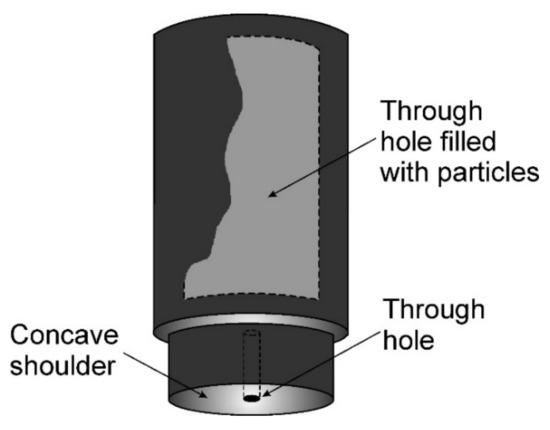
Figure 10.
Direct friction stir-processing tool (authors’ own drawing).
Yet another solution was proposed by Takhakh and Abdulla [73]. The authors used a tool equipped with a pin, while SiC particles were introduced into the working area through two holes that were located around the pin (Figure 11). The reinforcing phase was SiC powder with a grain size of 3.5 μm, and the matrix material was AA7075 aluminum alloy. The use of a tool with a pin made it possible to increase the depth of the stirred metals and to increase the amount of heat generated in the process. The authors used a tool additionally equipped with an internal helical spring, which presses the powder through the piston and pushes it out of the powder tank into the working zone. The applied solution helped to get the powder out of the tool, and thus minimized the problem of possible plugging of the channels supplying the powder to the working zone, and thus guaranteed more even and predictable powder dosing to this zone. As a result of processing the material with the DFSP method, the authors obtained a composite microstructure in the surface layer of the AA7075 alloy and an increase in the hardness of the alloy by 21%.
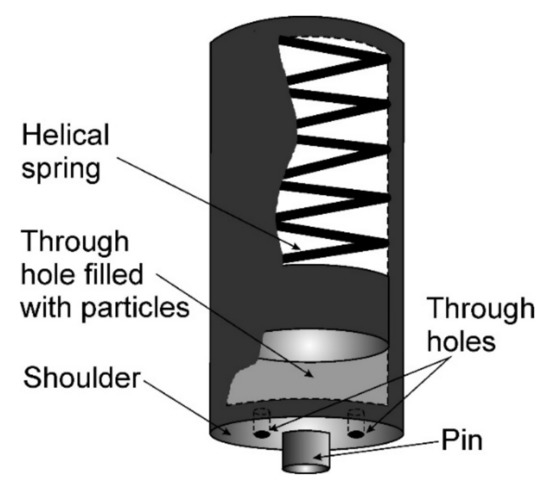
Figure 11.
Direct friction stir-processing tool (authors’ own drawing).
The list of cited works by the type of composite, FSP parameters and main results is presented in Table 4.

Table 4.
List of cited works.
2.5. Modifying the Microstructure of Composites with FSP
FSP technology can be used not only for the production of composites, but also to induce specific changes in the microstructure and properties of an already existing composite material. The effect of these changes is in this case not only the result of the FSP parameters, but also of the initial microstructure of the composite subjected to FSP. Friction stir processing of composites may result in a more uniform distribution of the reinforcing phase, strong refinement of the grain and particles of the reinforcing phase, a change in the shape of the reinforcing particles, the elimination of pores, agglomerates and other microstructure defects or casting defects.
Composites reinforced with particles and produced by casting methods are most often subjected to FSP. For example, in [74], FSP was applied to a gravity cast composite with an AlMg10 matrix, reinforced with SiC particles. FSP was made using a pin tool with a threaded side surface. As a result of FSP, favorable changes in the microstructure of the material were found, in particular, strong refinement of the matrix grain, in addition to the disappearance of casting defects and agglomerates of SiC particles abundant in the starting composite. The treatment was also accompanied by a more uniform distribution of SiC particles in the metal matrix and their strong refinement, combined with a change in the shape of the particles from polyhedral and sharp edged to more equiaxed. As a result of the refinement of the SiC particles, their number per unit area clearly increased, as it was more than twice higher in the FSPed alloy than in the starting material (Figure 12). Moreover, favorable changes in the microstructure of the composite increased the hardness of the material by about 35%.
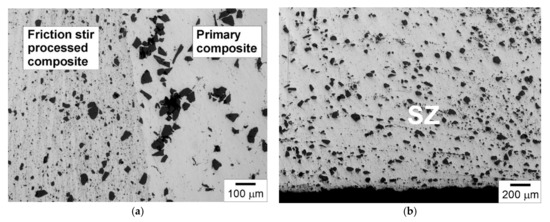
Figure 12.
Microstructure of AlMg10/SiC composite on border of modified zone and core material (a), microstructure in stirring zone (b), light microscopy, non-etched (authors’ own materials, unpublished).
The friction stir processing of a particle reinforced composite was also the subject of research by Kurtyka et al. [75]. They analyzed the effect of FSP on the concentration and distribution of SiC reinforcement particles in the A339/SiC/p composite and the mechanical properties of the composite. The authors found significant improvement in the distribution of the reinforcing phase particles, while increasing the compressive strength of the FSPed composite by approximately 40% and the material hardness by approximately 30%. In turn, Bauri et al. [76] investigated the possibility of improving the homogeneity of TiC particle distribution in a cast Al–TiC composite by means of FSP. The authors analyzed the effect of single- and double-pass FSP on the microstructure and properties of the composite. The authors found strong grain refinement and improved homogeneity of the particle distribution in the composite after FSP. In the case of double-pass FSP, the authors also found that the casting defects were eliminated. The microstructural changes caused by the surface treatment were accompanied by a marked increase in the hardness of the composite. In turn, Stawiarz et al. [77] showed that the modification of the Al–Si–Cu/SiC/p composite by means of FSP technology reduces the anisotropy coefficient of the distribution of the reinforcing phase particles by an order of magnitude, also leads to a reduction in the size of the reinforcing phase particles, an increase in hardness by 30% and a reduction in wear by 25% in the tribological test.
The list of cited works by the type of composite, FSP parameters and main results is presented in Table 5.

Table 5.
List of cited works.
3. Summary
Table 6 presents the comparative characteristics of the individual methods of producing surface composites and indicates the main advantages and disadvantages of the individual solutions that determine their application potential.

Table 6.
Comparative characteristics of individual methods.
4. Conclusions
Friction stir processing is one of the most promising surface engineering techniques, enabling the modification of the surface layers of engineering materials, including the formation of a composite microstructure in these layers. The literature data clearly shows that the production of a composite in the surface layer of the material leads to improvement in a number of key parameters such as hardness, wear resistance, and corrosion resistance, which justifies the production of the composite and the utilization of FSP technology for this purpose. Currently, there are a number of solutions allowing the effective introduction of the reinforcing phase, and thus the production of the composite microstructure. The most common method of producing composites is the groove method, also the method with the longest history, which partly explains its dominance and popularity. The hole method and DFSP are equally effective in producing a composite microstructure, and in many respects, give the operator more freedom and operational possibilities than the groove method. DFSP is a very promising solution and it has the greatest potential to become the dominant solution in the future. The application potential of the DFSP method results, among others, from the fact that the necessity for time-consuming and laborious preparation of the sample for FSP is eliminated, i.e., making the groove or holes and their subsequent filling with reinforcing material. In addition, in the case of DFSP the operator is not limited in the choice of the sample site to be treated.
FSP technology is constantly being developed, new trends and solutions appear, the main goal of which is to obtain the highest degree of grain refinement or the best mechanical properties. The solutions setting new trends and directions include, for example, friction stir vibration processing, in which vibration is the supporting factor for FSP, as well as the methods and solutions using additional cooling systems, thanks to which greater intensity of heat dissipation is obtained than in the case of cooling in normal air conditions.
Summing up, regardless of the method of introducing the reinforcing phase into the matrix, the use of FSP technology for the production of surface composites has a high application potential and is a competitive solution to other methods of producing composites such as as plasma spraying or electron beam welding (EBM) techniques.
Author Contributions
Conceptualization, J.I.; Writing—Original draft preparation, J.I. and M.S., Writing—review and editing, J.I. and M.S.; Visualization, J.I. and M.S.; Supervision, J.I. All authors have read and agreed to the published version of the manuscript.
Funding
This research received no external funding.
Conflicts of Interest
The authors declare no conflict of interest.
References
- Mishra, R.S.; Mahoney, M.W.; McFadden, S.X.; Mara, N.A.; Mukherjee, A.K. High strain rate superplasticity in a friction stir processed 7075 Al alloy. Scr. Mater. 1999, 42, 163–168. [Google Scholar] [CrossRef]
- Mishra, R.S.; Mahoney, M.W. Friction stir processing: A new grain refinement technique to achieve high strain rate superplasticity in commercial alloys. Mater. Sci. Forum 2001, 357–359, 507–514. [Google Scholar] [CrossRef]
- Thomas, W.M.; Nicholas, E.D.; Needham, J.C.; Murch, M.G.; Smith, P.T.; Dawes, C.J. Friction Stir Butt Welding. GB Patent 9125978, 6 December 1991. [Google Scholar]
- Kraiklang, R.; Onwong, J.; Santhaweesuk, C. Multi-performance characteristics of AA5052 + 10% SiC surface composite by friction stir processing. J. Compos. Sci. 2020, 4, 36. [Google Scholar] [CrossRef] [Green Version]
- Gan, Y.X.; Solomon, D.; Reinbolt, M. Friction stir processing of particle reinforced composite. Materials 2010, 3, 329–350. [Google Scholar] [CrossRef] [Green Version]
- Iwaszko, J.; Kudła, K. Friction stir processing of copper. In Proceedings of the 28th International Conference on Metallurgy and Materials (METAL 2019), Brno, Czech Republic, 22–24 May 2019; pp. 1051–1056. [Google Scholar] [CrossRef]
- Tamadon, A.; Pons, D.J.; Clucas, D. EBSD characterization of bobbin friction stir welding of AA6082-T6 aluminum alloy. Adv. Mater. Sci. 2020, 20, 49–74. [Google Scholar] [CrossRef]
- Wang, N.; Cao, L.; Yin, K. The microstructure, hardness and friction and wear behavior of AM60B magnesium alloy by friction stir processing. In Proceedings of the 2019 International Conference on Robotics, Intelligent Control and Artificial Intelligence, Shanghai, China, 20–22 September 2019; pp. 73–76. [Google Scholar] [CrossRef]
- Janeczek, A.; Tomków, J.; Fydrych, D. The influence of tool shape and process parameters on the mechanical properties of AW-3004 aluminium alloy friction stir welded joints. Materials 2021, 14, 3244. [Google Scholar] [CrossRef] [PubMed]
- Kosturek, R.; Śnieżek, L.; Torzewski, J.; Wachowski, M. The influence of welding parameters on macrostructure and mechanical properties of Sc-modified AA2519-T62 FSW joints. Manuf. Rev. 2020, 7, 28. [Google Scholar] [CrossRef]
- Sharma, V.; Prakash, U.; Manoj Kumar, B.V. Surface composites by friction stir processing: A review. J. Mater. Process. Technol. 2015, 224, 117–134. [Google Scholar] [CrossRef]
- Pouraliakbar, H.; Beygi, R.; Fallah, V.; Monazzah, A.H.; Mohammad, M.; Jandaghi, M.R.; Khalaj, G.; Da Silva, L.F.M.; Pavese, M. Processing of Al-Cu-Mg alloy by FSSP: Parametric analysis and the effect of cooling environment on microstructure evolution. Mater. Lett. 2022, 308, 131157. [Google Scholar] [CrossRef]
- Iwaszko, J.; Kudła, K.; Fila, K.; Strzelecka, M. The effect of friction stir processing (FSP) on the microstructure and properties of AM60 magnesium alloy. Arch. Metall. Mater. 2016, 61, 1209–1214. [Google Scholar] [CrossRef] [Green Version]
- Li, K.; Liu, X.; Zhao, Y. Research status and prospect of friction stir processing technology. Coatings 2019, 9, 129. [Google Scholar] [CrossRef] [Green Version]
- Sajed, M. Parametric study of two-stage refilled friction stir spot welding. J. Manuf. Process. 2016, 24, 307–317. [Google Scholar] [CrossRef]
- Ralls, A.M.; Kasar, A.K.; Menezes, P.L. Friction stir processing on the tribological, corrosion, and erosion properties of steel: A review. J. Manuf. Mater. Process. 2021, 5, 97. [Google Scholar] [CrossRef]
- Merah, N.; Abdul Azeem, M.; Abubaker, H.M.; Al-Badour, F.; Albinmousa, J.; Sorour, A.A. Friction stir processing influence on microstructure, mechanical, and corrosion behavior of steels: A review. Materials 2021, 14, 5023. [Google Scholar] [CrossRef] [PubMed]
- Mishra, R.S.; Ma, Z.Y.; Charit, I. Friction stir processing: A novel technique for fabrication of surface composite. Mater. Sci. Eng. A 2003, 341, 307–310. [Google Scholar] [CrossRef]
- Kumar, M.; Prasanth, R.; Selvakumar, B.; Ranjith, V. A review on friction stir processing of Al6061 surface composites. AIP Conf. Proc. 2019, 2128, 020031. [Google Scholar] [CrossRef]
- Bagheri, B.; Abdollahzadeh, A.; Sharifi, F.; Abbasi, M. The role of vibration and pass number on microstructure and mechanical properties of AZ91/SiC composite layer during friction stir processing. Proc. Inst. Mech. Eng. Part C J. Mech. Eng. Sci. 2021. Available online: https://journals.sagepub.com/doi/abs/10.1177/09544062211024281 (accessed on 6 November 2021). [CrossRef]
- Khan, M.; Rehman, A.; Aziz, T.; Shahzad, M.; Naveed, K.; Subhani, T. Effect of inter-cavity spacing in friction stir processed Al 5083 composites containing carbon nanotubes and boron carbide particles. J. Mater. Process Tech. 2018, 253, 72–85. [Google Scholar] [CrossRef]
- Huang, G.; Hou, W.; Shen, Y. Evaluation of the microstructure and mechanical properties of WC particle reinforced aluminum matrix composites fabricated by friction stir processing. Mater. Charact. 2018, 138, 26–37. [Google Scholar] [CrossRef]
- Marczyk, J.; Nosal, P.; Hebda, M. Effect of friction stir processing on microstructure and microhardness of Al–TiC composites. In Proceedings of the Student’s Conference STC, Prague, Czech Republic, 11 April 2018. [Google Scholar]
- Velmurugan, T.; Subramanian, R.; Suganya Priyadharshini, G.; Raghu, R. Experimental investigation of microstructure, mechanical and wear characteristics of Cu-Ni/ZrC composites synthesized through friction stir processing. Arch. Metall. Mater. 2020, 65, 565–574. [Google Scholar] [CrossRef]
- Kim, J.-Y.; Hwang, J.-W.; Lee, S.-M.; Hyun, C.-Y.; Park, I.-K.; Byeon, J.-W. Effect of process variables on friction stirred microstructure and surface hardness of AZ31 magnesium alloy. Arch. Metall. Mater. 2019, 64, 907–911. [Google Scholar] [CrossRef]
- Vaira Vignesh, R.; Padmanaban, R.; Govindaraju, M. Synthesis and characterization of magnesium alloy surface composite (AZ91D-SiO2) by friction stir processing for bioimplants. Silicon 2020, 12, 1085–1102. [Google Scholar] [CrossRef]
- Rao, D.S.; Gupta, B.G.; Rao, T.V.; Manikanta, J.E. Mechanical and microstructural behaviour of aluminium/TiB2 composites fabricated through multi-pass friction stir processing. Mater. Today Proc. 2021, 44, 413–418. [Google Scholar] [CrossRef]
- Akshay, B.R.; Keshavamurthy, R.; Kuppahalli, P.; Madhu Sudhan, J. Mechanical properties of friction stir processed Al6061-BN surface composite. Mater. Today Proc. 2018, 5, 24568–24577. [Google Scholar] [CrossRef]
- Thankachan, T.; Soorya Prakash, K.; Kavimani, V. Investigations on the effect of friction stir processing on Cu-BN surface composites. Mater. Manuf. Process. 2018, 33, 299–307. [Google Scholar] [CrossRef]
- Liang, J.; Li, H.; Qi, L.; Tian, W.; Li, X.; Chao, X.; Wei, J. Fabrication and mechanical properties of CNTs/Mg composites prepared by combining friction stir processing and ultrasonic assisted extrusion. J. Alloy. Compd. 2017, 728, 282–288. [Google Scholar] [CrossRef]
- Sanusi, K.O.; Akinlabi, E.T. Experimental investigation of magnesium alloy processed by friction stir process using stainless steel powder as matrix composite. Mater. Today Proc. 2018, 5, 18468–18474. [Google Scholar] [CrossRef]
- Hanas, T.; Sampath Kumar, T.S.; Perumal, G.; Doble, M.; Ramakrishna, S. Electrospun PCL/HA coated friction stir processed AZ31/HA composites for degradable implant applications. J. Mater. Process. Technol. 2018, 252, 398–406. [Google Scholar] [CrossRef]
- Dinaharan, I.; Akinlabi, E.T. Low cost metal matrix composites based on aluminum, magnesium and copper reinforced with fly ash prepared using friction stir processing. Compos. Commun. 2018, 9, 22–26. [Google Scholar] [CrossRef]
- Salehi, M.; Farnoush, H.; Mohandesi, J.A. Fabrication and characterization of functionally graded Al–SiC nanocomposite by using a novel multistep friction stir processing. Mater. Des. 2014, 63, 419–426. [Google Scholar] [CrossRef]
- El-Mahallawy, N.A.; Zoalfakar, S.; Maboud, A.A.G.A. Microstructure and mechanical properties of Al/SiC surface composite with different volume fractions using friction stir process. IOP Conf. Ser. Mater. Sci. Eng. 2019, 634, 012046. [Google Scholar] [CrossRef] [Green Version]
- Wang, T.; Gwalani, B.; Shukla, S.; Frank, M.; Mishra, R.S. Development of in situ composites via reactive friction stir processing of Ti–B4C system. Compos. B. Eng. 2019, 172, 54–60. [Google Scholar] [CrossRef]
- Ding, Z.; Zhang, C.; Xie, L.; Zhang, L.-C.; Wang, L.; Lu, W. Effects of friction stir processing on the phase transformation and microstructure of TiO2-compounded Ti-6Al-4V alloy. Metall. Mater. Trans. A 2016, 47, 5675–5679. [Google Scholar] [CrossRef]
- Iwaszko, J.; Kudła, K. Characterization of Cu/SiC surface composite produced by friction stir processing. Bull. Pol. Acad. Sci. Tech. Sci. 2020, 68, 555–564. [Google Scholar] [CrossRef]
- Bagheri, B.; Abbasi, M. Development of AZ91/SiC surface composite by FSP: Effect of vibration and process parameters on microstructure and mechanical characteristics. Adv. Manuf. 2020, 8, 82–96. [Google Scholar] [CrossRef]
- Sharma, A.; Sharma, V.M.; Sahoo, B.; Joseph, J.; Paul, J. Study of nano-mechanical, electrochemical and raman spectroscopic behavior of Al6061-SiC-Graphite hybrid surface composite fabricated through friction stir processing. J. Compos. Sci. 2018, 2, 32. [Google Scholar] [CrossRef] [Green Version]
- Azizieh, M.; Kim, H.S.; Kokabi, A.H.; Shahraki, B.K. Fabrication of AZ31/Al2O3 nanocomposites by friction stir processing. Rev. Adv. Mater. Sci. 2011, 28, 85–89. [Google Scholar]
- Sharma, A.; Maheshwari, S.; Khanna, P. Surface composite fabrication by friction stir processing: A review. E3S Web Conf. 2021, 309, 01150. [Google Scholar] [CrossRef]
- Zakaria, H.M. Microstructural and corrosion behavior of Al/SiC metal matrix composites. Ain Shams Eng. J. 2014, 5, 831–838. [Google Scholar] [CrossRef]
- Moharami, A.; Razaghian, A. Corrosion behaviour of friction stir processed Al–Mg2Si composites. Mater. Sci. Technol. 2020, 36, 1922–1929. [Google Scholar] [CrossRef]
- Heidarzadeha, A.; Pouraliakbarb, H.; Mahdavic, S.; Jandaghi, M.R. Ceramic nanoparticles addition in pure copper plate: FSP approach, microstructure evolution and texture study using EBSD. Ceram. Int. 2018, 44, 3128–3133. [Google Scholar] [CrossRef]
- Pol, N.; Verma, G.; Pandey, R.P.; Shanmugasundaram, T. Fabrication of AA7005/TiB2-B4C surface composite by friction stir processing: Evaluation of ballistic behavior. Def. Technol. 2019, 15, 363e368. [Google Scholar] [CrossRef]
- Iwaszko, J.; Kudła, K. Microstructure, hardness, and wear resistance of AZ91 magnesium alloy produced by friction stir processing with air-cooling. Int. J. Adv. Manuf. Technol. 2021, 116, 1309–1323. [Google Scholar] [CrossRef]
- Almazrouee, A.I.; Al-Fadhalah, K.J.; Alhajeri, S.N. A New approach to direct friction stir processing for fabricating surface composites. Crystals 2021, 11, 638. [Google Scholar] [CrossRef]
- Sathish, T.; Kaladgi, A.R.R.; Mohanavel, V.; Arul, K.; Afzal, A.; Aabid, A.; Baig, M.; Saleh, B. Experimental Investigation of the Friction Stir Weldability of AA8006 with zirconia particle reinforcement and optimized process parameters. Materials 2021, 14, 2782. [Google Scholar] [CrossRef]
- Papantoniou, I.G.; Markopoulos, A.P.; Manolakos, D.E. A new approach in surface modification and surface hardening of aluminum alloys using friction stir process: Cu-reinforced AA5083. Materials 2020, 13, 1278. [Google Scholar] [CrossRef] [Green Version]
- Cao, G.; Zhang, L.; Zhang, D.; Liu, Y.; Gao, J.; Li, W.; Zheng, Z. Microstructure and properties of nano-hydroxyapatite reinforced WE43 alloy fabricated by friction stir processing. Materials 2019, 12, 2994. [Google Scholar] [CrossRef] [PubMed] [Green Version]
- Gangil, N.; Nagar, H.; Mohammed, S.M.A.K.; Singh, D.; Siddiquee, A.N.; Maheshwari, S.; Chen, D.L. Fabrication of magnesium–NiTip composites via friction stir processing: Effect of tool profile. Metals 2020, 10, 1425. [Google Scholar] [CrossRef]
- Heidarzadeh, A.; Taghizadeh, B.; Mohammadzadeh, A. In-situ formation of Zn oxide particles in CuZn matrix during friction stir processing. J. Adhes. Sci. Technol. 2021, 35, 1006–1013. [Google Scholar] [CrossRef]
- Gupta, M.K. Effects of tool pin profile and feed rate on wear performance of pine leaf ash/Al composite prepared by friction stir processing. J. Adhes. Sci. Technol. 2021, 35, 256–268. [Google Scholar] [CrossRef]
- Liu, F.; Li, Y.; Sun, Z.; Ji, Y. Corrosion resistance and tribological behavior of particles reinforced AZ31 magnesium matrix composites developed by friction stir processing. J. Mater. Res. Technol. 2021, 11, 1019–1030. [Google Scholar] [CrossRef]
- Liu, P.; Sun, Q.-Z.; Liu, Y.; Sun, Q.-L. Microstructure and corrosion properties of 5A06 aluminum matrix surface composite fabricated by friction stir processing. Sci. Eng. Compos. Mater. 2013, 20, 123–127. [Google Scholar] [CrossRef]
- Blanco Fernandez, J.; Jimenez Macias, E.; Saenz-Diez Muro, J.C.; Caputi, L.S.; Miriello, D.; De Luca, R.; Sanchez Roca, A.; Carvajal Fals, H.D. Tribological behavior of AA1050H24-graphene nanocomposite obtained by friction stir processing. Metals 2018, 8, 113. [Google Scholar] [CrossRef] [Green Version]
- Srivastava, A.K.; Maurya, N.K.; Dixit, A.R.; Dwivedi, S.P.; Saxena, A.; Maurya, M. Experimental investigations of A359/Si3N4 surface composite produced by multi-pass friction stir processing. Mater. Chem. Phys. 2021, 257, 1–12. [Google Scholar] [CrossRef]
- Butola, R.; Tyagi, L.; Singari, R.M.; Murtaza, Q.; Kumar, H.; Nayak, D. Mechanical and wear performance of Al/SiC surface composite prepared through friction stir processing. Mater. Res. Express. 2021, 8, 1–11. [Google Scholar] [CrossRef]
- Iwaszko, J.; Kudła, K.; Fila, K.; Caban, R. Application of FSP technology in formation process of composite microstructure in AlZn5.5MgCu aluminium alloy surface layer reinforced with SiC particles. Compos. Theory Pract. 2017, 17, 51–56. [Google Scholar]
- Sharma, D.K.; Patel, V.; Badheka, V.; Mehta, K.; Upadhyay, G. Different reinforcement strategies of hybrid surface composite AA6061/(B4C+MoS2) produced by friction stir processing. Materialwiss. Werkstofftech. 2020, 51, 1493–1506. [Google Scholar] [CrossRef]
- Singh, S.; Rathi, K.; Pal, K. Synthesis, characterization of graphene oxide wrapped silicon carbide for excellent mechanical and damping performance for aerospace application. J. Alloy. Compd. 2018, 740, 436–445. [Google Scholar] [CrossRef]
- Komarasamy, M.; Mishra, R.S.; Baumann, J.A.; Grant, G.; Hovanski, Y. Friction Stir Welding and Processing VII; Springer: Berlin/Heidelberg, Germany, 2013. [Google Scholar] [CrossRef]
- Akramifard, H.R.; Shamanian, M.; Sabbaghian, M.; Esmailzadeh, M. Microstructure and mechanical properties of Cu/SiC metal matrix composite fabricated via friction stir processing. Mater. Des. 2014, 54, 838–844. [Google Scholar] [CrossRef]
- Sabbaghian, M.; Shamanian, M.; Akramifard, H.R.; Esmailzadeh, M. Effect of friction stir processing on the microstructure and mechanical properties of Cu–TiC composite. Ceram. Int. 2014, 40, 12969–12976. [Google Scholar] [CrossRef]
- Mohammed, M.H.; Subhi, A.D. Exploring the influence of process parameters on the properties of SiC/A380 Al alloy surface composite fabricated by friction stir processing. Eng. Sci. Technol. Int. J. 2021, 69, e136735. [Google Scholar] [CrossRef]
- Iwaszko, J.; Kudła, K.; Fila, K. Technological aspects of friction stir processing of AlZn5.5MgCu aluminum alloy. Bull. Pol. Acad. Sci. Tech. Sci. 2018, 66, 713–719. [Google Scholar] [CrossRef]
- Barmouz, M.; Zall, V.; Pashazadeh, H. Mechanical and microstructural characterization of hybrid Cu-SiC-Zn composites fabricated via friction stir processing. Mater. Res. 2016, 19, 1292–1298. [Google Scholar] [CrossRef] [Green Version]
- Ratna Sunil, B. Different strategies of secondary phase incorporation into metallic sheets by friction stir processing in developing surface composites. Int. J. Mech. Mater. Eng. 2016, 11, 12. [Google Scholar] [CrossRef] [Green Version]
- Houshyar, M.; Nourouzi, S.; Aval, H.J. Sandwich method: Strategy to fabricate Al/SiC composites by FSP. Trans. Indian Inst. Met. 2019, 72, 3249–3259. [Google Scholar] [CrossRef]
- Mertens, A.; Simar, A.; Montrieux, H.-M.; Halleux, J.; Lecomte-Beckers, J. Friction stir processing of magnesium matrix composites reinforced with carbon fibres: Influence of the matrix characteristics and of the processing parameters on microstructural developments. In Proceedings of the 9th International Conference on Magnesium Alloys and their Applications, Vancouver, BC, Canada, 8–12 July 2012; pp. 845–850. Available online: http://hdl.handle.net/2268/120134 (accessed on 22 November 2021).
- Huang, Y.; Wang, T.; Guo, W.; Wan, L.; Lv, S. Microstructure and surface mechanical property of AZ31 Mg/SiCp surface composite fabricated by direct friction stir processing. Mater. Des. 2014, 59, 274–278. [Google Scholar] [CrossRef]
- Takhakh, A.M.; Abdulla, H.H. Improving the mechanical properties of Al7075-T651 welded joint using direct friction stir processing. In Proceedings of the Second Conference of Post Graduate Researches (CPGR’2017), Baghdad, Iraq, 4 October 2017. [Google Scholar]
- Iwaszko, J.; Kudła, K. Effect of friction stir processing (FSP) on microstructure and hardness of AlMg10/SiC composite. Bull. Pol. Acad. Sci. Tech. Sci. 2019, 67, 185–192. [Google Scholar] [CrossRef]
- Kurtyka, P.; Rylko, N.; Tokarski, T.; Wójcicka, A.; Pietras, A. Cast aluminium matrix composites modified with using FSP process–changing of the structure and mechanical properties. Compos. Struct. 2015, 133, 959–967. [Google Scholar] [CrossRef]
- Bauri, R.; Yadav, D.; Suhas, G. Effect of friction stir processing (FSP) on microstructure and properties of Al–TiC in situ composite. Mater. Sci. Eng. A 2011, 528, 4732–4739. [Google Scholar] [CrossRef]
- Stawiarz, M.; Kurtyka, P.; Rylko, N.; Gluzman, S. Influence o FSP process modification on selected properties of Al-Si-Cu/SiC composite surface layer. Compos. Theory Pract. 2019, 19, 161–168. [Google Scholar]
Publisher’s Note: MDPI stays neutral with regard to jurisdictional claims in published maps and institutional affiliations. |
© 2021 by the authors. Licensee MDPI, Basel, Switzerland. This article is an open access article distributed under the terms and conditions of the Creative Commons Attribution (CC BY) license (https://creativecommons.org/licenses/by/4.0/).